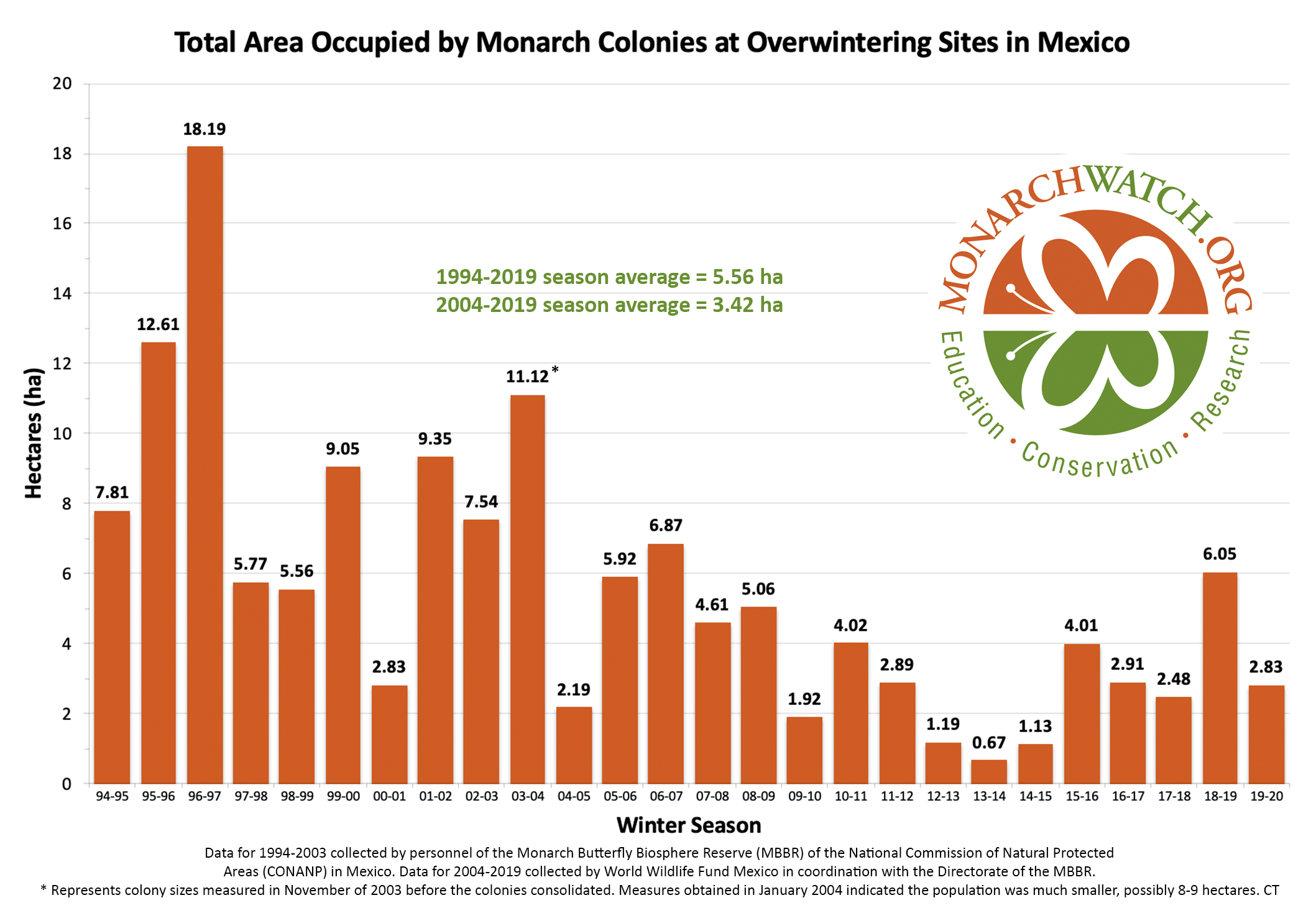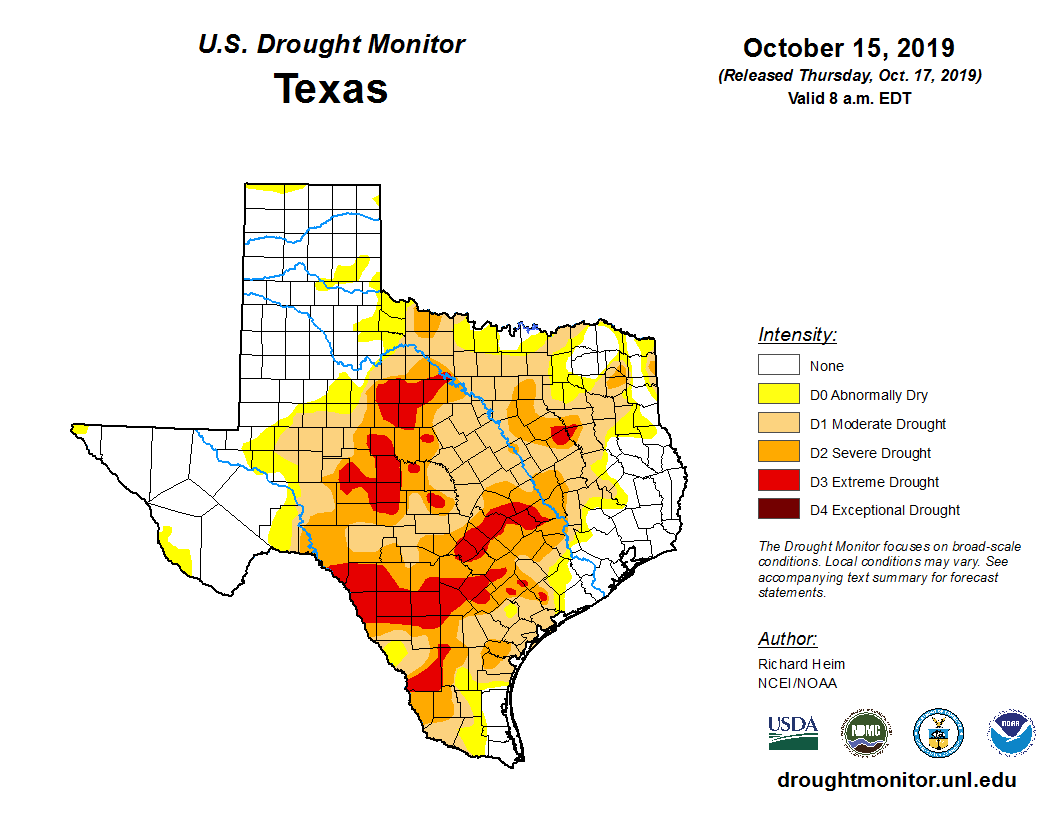Monarch Population Status
Friday, March 13th, 2020 at 12:24 pm by Jim LovettFiled under Monarch Population Status | Comments Off on Monarch Population Status
World Wildlife Fund Mexico in collaboration with CONANP and the Monarch Butterfly Biosphere Reserve (MBBR) announced the total forest area occupied by overwintering monarch colonies today. Eleven (11) colonies were located this winter season with a total area of 2.83 hectares, a 53.22% decrease from the previous season (6.05 ha):

Figure 1. Total Area Occupied by Monarch Colonies at Overwintering Sites in Mexico.
WWF release (in spanish): La mariposa Monarca redujo en un 53% su ocupación en los bosques mexicanos de hibernación
Chip Taylor, Monarch Watch Director
In my November 2019 “Monarch Population Status” blog post (Why overwintering monarch numbers will be lower this year) I outlined my reasons for expecting lower monarch numbers.
I finished the article with a summary of bullet points which made sense to me given the data at hand at the time:
Population growth
• Less than optimal egg distribution in March and April
• Later recolonization of the Upper Midwest
• Low monarch production in Iowa and maybe western portions of the upper Midwest
• Lower summer temperatures than in 2018Migration
• Late migrations are associated with lower numbers reaching Mexico
• Droughts are associated with lower numbers reaching Mexico
• High numbers in the northeast do not translate to high overwintering numbers
• Northeast butterflies take too long to migrate southwest
In the text that follows, I will elaborate on these points.
Conditions were less favorable for population growth in 2019 than in 2018. Although the temperatures in March 2019 were near the long-term average, monarchs still moved too far north too soon with many laying eggs at latitudes with cooler weather. With cooler temperatures, the immatures develop more slowly, and the overall effect is to produce a first-generation cohort with an older average age to first reproduction. Growth rates of populations decrease as age to first reproduction increases. Because most first-generation monarchs migrate north in May and early June, the conditions during that time period are critical. In 2019, those conditions – mostly lower temperatures — delayed the recolonization of the summer breeding area north of 40°N. Delayed arrivals can ripple through the rest of the breeding season, resulting in a late migration.
Reports we receive during the summer alert us to booming populations, but silence from areas that are normally productive can be informative as well. Last August we heard about large numbers of monarchs in several areas of the northeast, especially coastal Maine and parts of Wisconsin and southeast Minnesota, but there was silence from, or reports of low numbers from, the western portion of the Upper Midwest. Summer temperatures can be important with both extreme high or low temperatures leading to population decreases (see Monarchs are an enzyme – Part 1). Populations grow well with summer temperatures close to the long-term mean, and that was the case in 2019. However, they grow even better when temperatures are a couple of degrees above normal as they were in 2018.
While conditions for growth of the population weren’t as favorable in 2019 as they were in 2018, the two biggest factors that appear to account for the lower numbers this winter are the lateness of the migration and the drought in Texas. Both late migrations (Taylor, et al. 2019) and droughts (Saunders, et al. 2019) have been associated with lower overwintering numbers. In the earlier post to the blog, I commented on the extreme lateness of the migration in September which I attributed to long periods of high temperatures north of Kansas that inhibited migratory flight. Although there have been a few late migrations through Kansas, since the late 1980s, the two-week-late passage of monarchs in 2019 was absolutely the latest to date. Although we have no way to be certain, hot dry weather probably takes a toll on the monarchs. Longer migrations in terms of the number of days in flight likely add to this attrition. As the migration moved into Texas, nectar was in short supply due to the drought (Figure 2).

Figure 2. U.S. Drought Monitor, Texas 15 October 2019.
Because Texas and northeast Mexico share weather patterns in addition to a border, it’s likely that monarchs continued to experience drought conditions as they entered northeastern Mexico. If so, the drought could have taken a considerable toll of the monarchs with low lipid reserves. However, how much drought monarchs experienced in Mexico in October isn’t clear. The end of the migration monarchs we sampled here in Lawrence, Kansas were both smaller than average and substantially below average in mass and thus ill-prepared to reach Mexico.
In the earlier text, I predicted that the overwintering number would be 4.7 hectares. Having made that claim I pointed out that:
I will be both right and wrong. I will be right about the size of the overwintering population relative to that of last year (6.05 hectares). The number this year will be lower. That’s been clear since late March and early April. I’ll explain why it will be lower below. The question I’ve been wrestling with is how much lower will the number be this winter. That’s where I’ll be wrong. I’ll never hit that number precisely. There are too many variables.
Given the numbers tallied by the World Wildlife Fund Mexico for the total hectares for 2019–2020 (2.83), where I was right and where I was wrong is clear to all. I’ll keep working at it.
References
Saunders, S. P., Ries, L., Neupane, N., Ramirez, M. I., Garcia-Serrano, E., Rendon-Salinas, E., and Zipkin, E. F. (2019). Multi-scale seasonal factors drive the size of winter monarch colonies. PNAS 116: 8609-8614. doi.org/10.1073/pnas.1805114116
Taylor, O.R., Lovett, J.P, Gibo, D.L., Weiser, E.L., Thogmartin, W.E., Semmens, D.J., Diffendorfer, J.E., Pleasants, J.M., Pecoraro, S.D., and Grundel, R. (2019). Is the timing, pace and success of the monarch migration associated with sun angle? Frontiers Ecology Evolution. published: 10 December 2019 doi.org/10.3389/fevo.2019.00442


Sorry, comments for this entry are closed at this time.